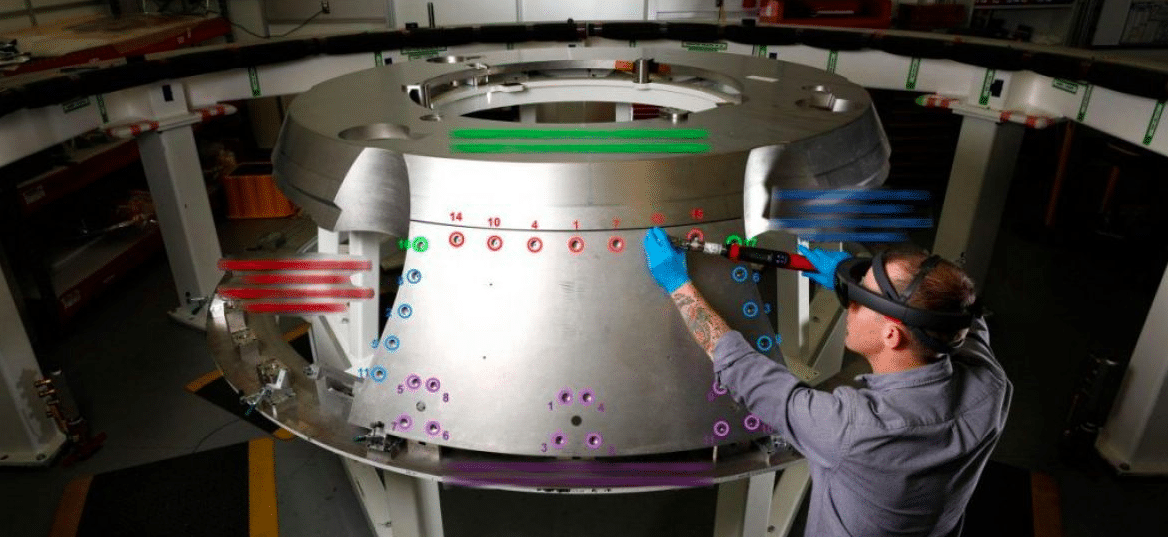
XR Talks is a weekly series that features the best presentations and educational videos from the XR universe. It includes embedded video, as well as narrative analysis and top takeaways. Speakers’ opinions are their own.
Enterprise AR is a rich area of opportunity, given continually-proven bottom line impact. In fact, it’s the largest XR sub-sector in the outer years of ARtillry Intelligence’s latest revenue forecast. That’s mostly driven by demonstrable ROI in areas like industrial productivity and error reduction.
But despite that ROI story, there’s still lots of enterprise inertia and risk aversion, said Scope AR CEO Scott Montgomerie at AWE Europe (video below). We believe it will take a while to get over that hump, but then adoption will accelerate as we saw with enterprise smartphone adoption.
To accelerate that process, it’s all about case studies and proof points. It’s also about moving enterprises past “pilot purgatory” says Montgomerie. That happens when innovation centers in a given company adopt technology but other constituents, like I.T. dept. and employees, don’t.

But it still starts with the case studies. And those are slowly building throughout the enterprise AR sector. Scope AR has been an exemplar in pulling together ROI proof points, including increased output, better accuracy rate in diagnosing problems, and reducing time for task completion.
For example, Scope AR’s WorkLink software for pre-authored AR instructions reduced Lockheed Martin’s “orient & decide” portion of a satellite assembly by 99 percent. This type of work is where AR shines, as it reduces the cognitive load that’s inherent in translating 2D manuals to 3D space.
“To put into common terms, think about IKEA furniture,” said Montgomerie. “You have to look at those paper instructions, read weird diagrams, and do mental mapping of those diagrams… Multiply the complexity of that by a thousand and that’s the challenge we’re facing.”

Beyond pre-authored AR instructions, remote AR assistance (a.k.a “see what I see”) is proving valuable. Fast-food equipment supplier Prince Castle used Scope AR’s Remote AR to fix on-site equipment. It achieved 100 percent first time diagnosis rate and a 50 percent labor cost reduction.
“There’s about thirty things that can go wrong with these pieces of equipment,” said Montgomerie. “Figuring out which one of those things have gone wrong is really the key, and just with a phone call, their diagnosis rate was terrible — about 90 percent failure in first-time Diagnosis.”

As we’ve examined, Remote AR can also have macro-effects in an organization, such as reducing impact from subject-matter experts retiring. Shifting them from field work to remote AR assistance can delay retirement. It can also optimize diminishing volumes of experts through telepresence.
“In the next five years, they’re going to lose 330 years worth of experience just by having baby boomers retiring,” said Montgomerie. “These guys have spent 35 years learning exactly how to maintain, fix and operate equipment, and that knowledge is literally walking out the door.”
Unilever realized this advantage, as well as the unit economics of lessened downtime. Using Remote AR, it was able to reduce downtime by 50 percent for an ROI of 1,717 percent. The benefit is having things fixed faster when you don’t have to wait for a human to travel to the site.

But again, ROI proof points only get you so far. It’s also about setting the technology up to succeed by appealing to stakeholders throughout an organization — business leaders, I.T. depts. and employees, says Montgomerie. And that’s more about marketing than technology.
Business leaders are the easy part, and are usually sold on the merits of case studies like the above. Then comes I.T., whose job is to be risk-averse. Montgomerie’s advice: Get them involved as soon as possible. That may seem counterintuitive but it pays dividends downstream.
“I think it’s a common mistake — one we’ve certainly made — to do an end run around I.T.,” said Montgomerie. “It’s easy to say ‘yeah, let’s prove the value first and then we’ll worry about I.T. when we get to scale. I.T. will screw you at that point, so you need to get them in the conversation early.”

He also recommends deploying AR through smartphones and tablets when possible. The I.T. and data security pushback is lower with mobile devices, given their tenure and trustworthiness in the enterprise. Headsets like the Hololens conversely haven’t gained that level trust from I.T. yet.
As for employees, it’s likewise hard to win them over. But successful deployment requires their buy in. Resistance includes fear of new technology and job security. Montgomerie recommends educating them on how it benefits them, and enlist change-management pros.
“We’re talking about some pretty impressive ROI numbers here,” he said. “If I’m a worker I’m thinking, ‘oh well, the company can still do exactly the same on their bottom line with 50 percent of the workforce… does that mean I have a 1 in 2 chance of keeping my job next year’.”

In a broader sense, Montgomerie recommends deploying AR where it works best. It doesn’t work in rote and automated functions, where employees are already fine-tuned. It shines in low-volume, high complexity situations (like space shuttles), or high volume, small improvement scenarios.
Put another way, don’t be a hammer searching for nails. Act in a needs-driven way to deploy AR in targeted and optimized ways. Scope AR took this path with aerospace, engineering and heavy equipment, but Montgomerie believes there are many other verticals primed for AR.
“I think there’s an impression out there that AR is great for everything. I can tell you it’s not,” he said. “We’ve chosen key industries to go after… there are other industries where this is a greenfield — things like medical, construction, and logistics. There are some great use cases there.”
For deeper XR data and intelligence, join ARtillry PRO and subscribe to the free AR Insider Weekly newsletter.
Disclosure: AR Insider has no financial stake in the companies mentioned in this post, nor received payment for its production. Disclosure and ethics policy can be seen here.
Header image credit: Lowes
